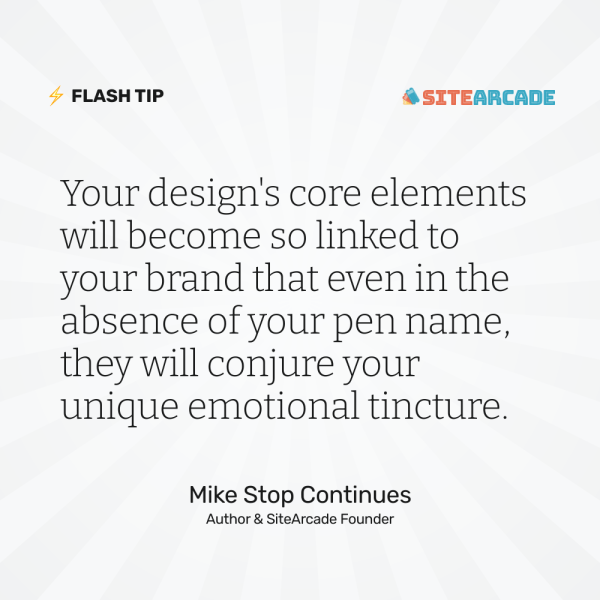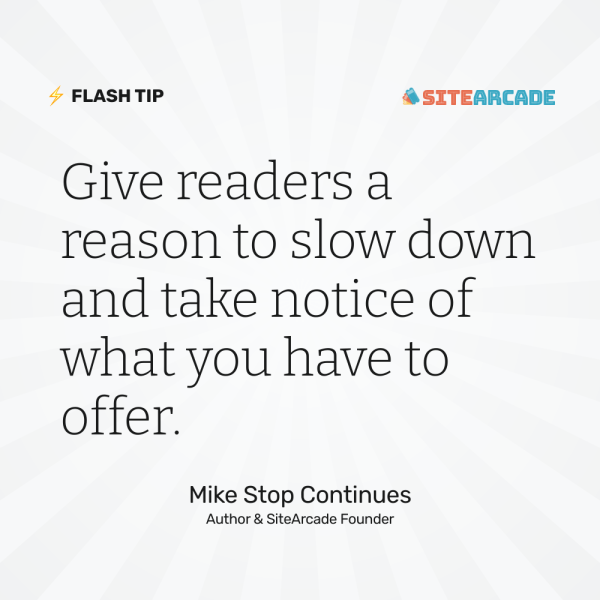How to Communicate Your Author Brand through Web Design
A website is 80% about the content, about creating, organizing, and presenting the many details of your author career. But to dismiss the remaining 20% of your site—the style—as unimportant would be a tragic mistake.
Much as a picture is worth a thousand words, the right color, font, or icon is worth ten thousand. The more primitive a design element is, the more power it has over the human psyche. The title of the novel The Yellow Wallpaper is one such primitive, evoking the potent feeling of unease, dementia, and decay.

Your brand’s core design elements should be equally gripping, as these details will follow you wherever you go. From your book covers to your promotional materials to your merchandise, the right color, font, and graphics will over time become so linked to your brand that even in the absence of your pen name, these elements will conjure the unique emotional tincture only you can provide.
For example, what comes to mind when I say: sweet, yellow, bent? (Here’s some more.)
The trick is selecting design elements that act in harmony with your author persona without sacrificing the strong sense of professionalism and approachability that should be key aspects of every author’s brand. Do this, and you’ll be able to go a decade or two between updates, which is approximately how often Nora Roberts, Stephen King, and James Patterson do.
Color
Trigger positive associations fast with a strong brand color, whether on book covers, in emails, or in convention swag. Make it symbolic, memorable, and different-enough from other authors in your genre.
Action Steps
- Select a brand color that matches your genre and unique style. Refer to our color guide in the links below.
- Check the contrast of your brand color with black and white as the background and foreground color. Aim for your brand color to be flexible.
- Explore color pairing and shades to use in future book covers, promotional materials, swag, and web design.
- Record your brand color’s hex code (e.g. #3aa8c3) and hue (e.g. 350deg). You will use them time and again!
Resources
- SiteArcade - How to Choose the Perfect Color for your Author Brand [10m read]
- Entrepreneur.com - The Role of Color in Branding [infographic]
Fonts
A strong font choice acts as the bridge between your books, your promotional materials, and your digital persona. Your selection should signal allegiance to your market, yet also hint at your unique spin.
Action Steps
- Select a logo font that is both unique and telling. Refer to our font guide in the links below.
- Select a serif and sans-serif font that matches your logo font for use across contexts. Different mediums require different pairings.
- Test and record different font pairings and styles. Make sure they’re branded, readable, and harmonious.
Resources
- SiteArcade - How to Choose the Perfect Author Fonts [9m read]
- Kaye Putnam - Font Personality: How to Pick Brand Fonts [8m video]
- Nick Kolenda - Font Psychology: A Full Guide [10m read]
Logo & Favicon
A picture is worth a thousand words. Whether in the browser tab or on your business card, your logo plays a powerful role in reminding readers of your unique contributions to the literary world.
Action Steps
- Select a unique graphic to serve as a favicon for your site as well as a reusable design element for your brand.
- Design your logo using a strong combination of brand colors, fonts, and graphics. Refer to our logo guide in the links below.
- Check your logo against white and black backgrounds. If necessary, prepare two versions.
- Export your logo in multiple sizes and add them to your style guide for quick access.
Resources
- SiteArcade - Designing a Fantastic Author Logo (with examples) [10m read]
- Satori Graphics - Logo Designing In 2021 - Are You Ready? [5m video]
Style & Layout
Not only must your brand assets be on point, but they must come together in a unified whole. Nowhere is this more important than on your website, where brand meets clarity, approachability, and professionalism.
Action Steps
- Research the homepages of the top ten best-selling authors in general and the top ten most-popular authors in your genre. Record how information is presented from the top of the page to the bottom.
- Sketch your ideal website, making sure you order things so that the most important information comes first, and the least important last.
- Repeat this process for the about-the-author page, solo book pages, and series pages (if relevant).
Resources
- UXPin - 12 Timeless UI Layouts & Website Design Patterns Analyzed [12m read]
- Flux - 3 Psychology Principles Every Web Designer Must know [11m video]
Final Thoughts
When it comes to design choices, the more you think about them beforehand, the better. If you start building your author website with just a vague sense of what you want to accomplish, your brand will come across as confusing and muddy—and since nobody wants to read a confusing and muddy book, such choices are likely to send readers packing!

A strong design not only compliments your content, but it also empowers your author brand. Give readers a reason to slow down and take notice of what you have to offer.
Just as in your own home, make your website stunning, cozy, and filled to the brim with personality!
Next step: How to Craft the Perfect Author Website CTAs.
See you then!